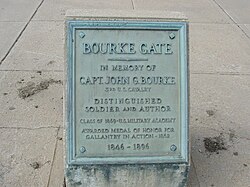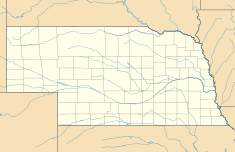| Fort Omaha Guardhouse | |
|---|---|
 Bourke Gate commemorative plaque located near guardhouse Bourke Gate commemorative plaque located near guardhouse | |
| Location | Omaha, Nebraska |
| Coordinates | 41°18′25″N 95°57′26″W / 41.30694°N 95.95722°W / 41.30694; -95.95722 |
| Built | 1883 |
| Omaha Landmark | |
| Designated | July 6, 1982 |
  | |
The Fort Omaha Guardhouse was built in 1883 to handle Native American, civilian and military prisoners of the Department of the Platte housed at Fort Omaha. Located at 5700 North 30th Street in north Omaha, Nebraska, the Guardhouse was named an Omaha Landmark by the City of Omaha Landmarks Heritage Preservation Commission in 1982. It is also a contributing property to the Fort Omaha Historic District, which is listed on the National Register of Historic Places.
About
Placed by the front gates, the Fort Omaha Guardhouse was built as part of a design typical of western United States military forts in the 19th century. Originally constructed as a large L-shaped building, the rear or east wing of the building, closest to North 30th Street, was dissected from the building around 1914. It was used as a storage facility for many years, and the main section of the guardhouse was converted to offices.
Big Spotted Horse was captive there in the 1880s. The most famous prisoner of the guardhouse was Ponca Chief Standing Bear during the trial of Standing Bear v. Crook. When General Crook visited him at the Guardhouse he was appalled by the terrible conditions Standing Bear and his tribal members were staying in.
Several other prisoners, including Army deserters, were housed there over the next forty years. There were also several prisoners who were land jumpers that claimed stakes in the Black Hills before 1875.
See also
References
- ^ "Landmarks Heritage Preservation Commission – List of Landmarks". Omaha Landmarks Heritage Preservation Commission. Archived from the original on 2013-10-16. Retrieved 2013-03-03.
- Lebow, E.F. (1998) A Grandstand Seat: The American Balloon Service in World War I. Greenwood Publishing Group p. 18.
- Greguras, F. (2000) "Omaha Military History." Retrieved 8/17/07.
- Hyde, G.E. (1951) The Pawnee Indians. University of Denver Press. p 229.
- Brown, D. (1971) Bury My Heart at Wounded Knee: An Indian History of the American West. Henry Holt Publishers. p. 359.
- Dando-Collins, S. (2004) Standing Bear Is a Person: The True Story of a Native American's Quest for Justice. Da Capo Press. p. 4.
- Daubenmier, J. (2004) "Empty Saddles: Desertion from the Dashing U.S. Cavalry." Montana: The Magazine of Western History. Autumn.
- Mills, A. and Claudy, C.H. (1918) My Story. p. 157.
External links
| North Omaha, Nebraska | |
|---|---|
| History | |
| Neighborhoods | |
| Events | |
| Landmarks |
|
| People | |
| Culture | |
| Schools |
|
| Churches | |
| Transportation | |
| Other | |
- Guardhouses
- Landmarks in North Omaha, Nebraska
- National Register of Historic Places in Omaha, Nebraska
- Buildings and structures in Omaha, Nebraska
- Forts in Nebraska
- Defunct prisons in Nebraska
- Military facilities on the National Register of Historic Places in Nebraska
- Jails on the National Register of Historic Places
- Jails on the National Register of Historic Places in Nebraska
- 1883 establishments in Nebraska